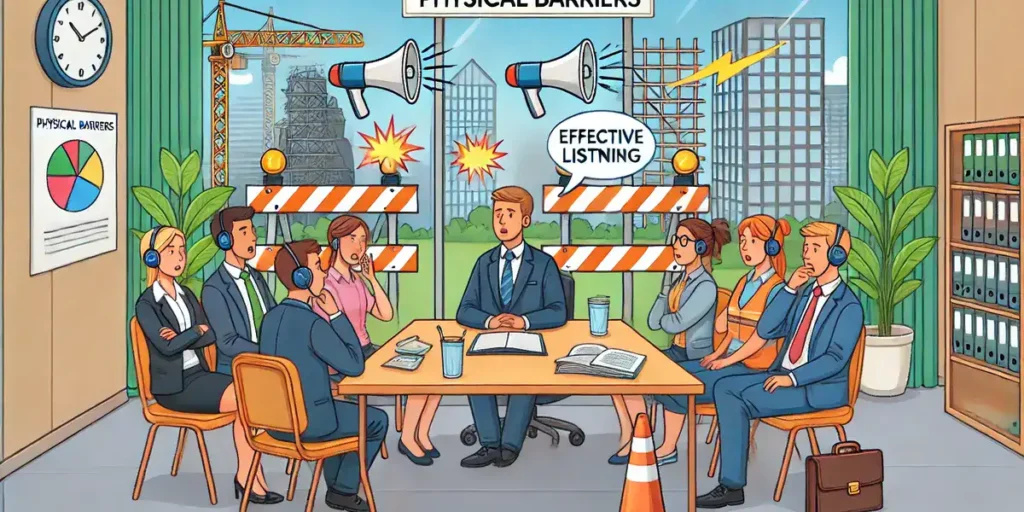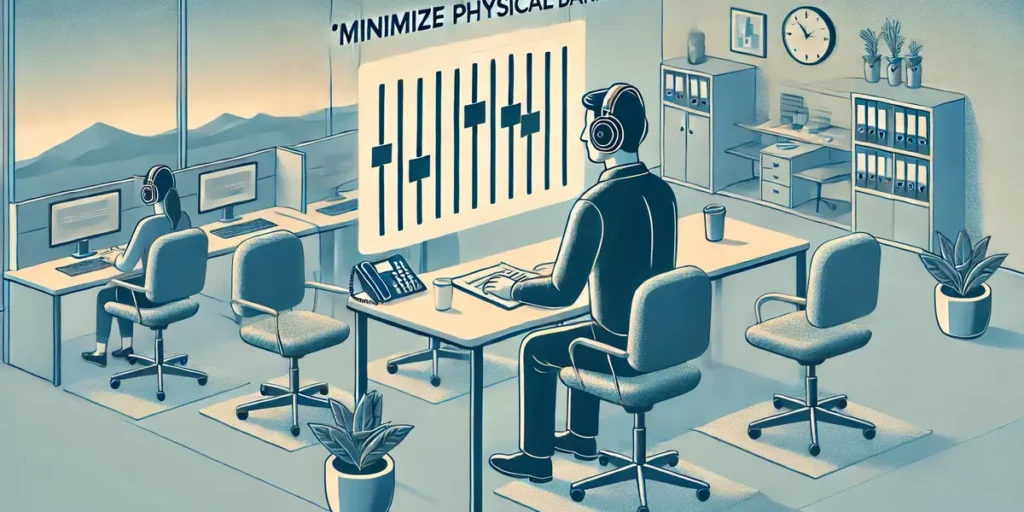Listening is a crucial skill for effective communication, yet it often faces various obstacles that hinder our ability to fully comprehend and engage with others. These barriers to listening can arise from external distractions, personal biases, emotional states, language differences, and more. Understanding these barriers is essential for improving our listening abilities and fostering better interpersonal connections. By identifying and addressing these challenges, we can enhance our communication skills and build stronger relationships both personally and professionally.
Types of listening barriers in communication
Listeners encounter various barriers that can affect the effectiveness of communication. Below are some common types of listening barriers in communication.
Physical Barriers

Physical barriers, like noise and speech impairments, significantly impact listening. For instance, loud construction noise outside a meeting room can distract participants, making it hard to follow the discussion. Speech impairments, such as stuttering, can cause misunderstandings if the speaker’s message isn’t clear.
Psychological Barriers
Psychological barriers stem from internal mindsets, affecting a listener’s ability to focus or understand. Personal biases play a huge role here; if a listener has a preconceived notion about the speaker, it skews their interpretation. Emotional states, like anger or stress, also disrupt attentive listening. If I’m angry, I’m less likely to fully engage with what’s being said, leading to poor comprehension.

Environmental Barriers
Environmental barriers encompass poor settings and surrounding distractions. An example is a poorly lit room which can make it difficult for participants to stay alert during a lengthy presentation. Open office spaces may also introduce various interruptions, from colleagues’ conversations to phone ringing, hindering effective listening.
Physiological Barriers
Physiological barriers include hearing loss or physical ailments that affect the listener’s ability to receive messages. Temporary conditions, like a bad cold, can also reduce the capacity to listen effectively. If I’m battling a severe headache, my focus and attention plummet, impacting my listening ability.
semantic Barriers
Semantic barriers occur when there’s a misunderstanding due to language or jargon differences. For example, industry-specific terminology can confuse someone unfamiliar with the terms. If a software engineer uses technical jargon while explaining a concept to a layperson, it creates a semantic barrier, complicating the communication.
Attitudinal Barriers
Attitudinal barriers arise from the listener’s attitudes and perspectives. If I believe the speaker isn’t credible, I might dismiss their message without fully listening. Neglecting to listen actively out of disinterest or prejudice also constitutes an attitudinal barrier.
Cultural Barriers
Cultural differences can lead to misinterpretations if the listener isn’t aware of various cultural norms and language nuances. For example, gestures and expressions may carry different meanings across cultures, leading to confusion and miscommunication. If a speaker’s cultural background influences their communication style, it may pose a challenge to effective listening for those unfamiliar with those cultural cues.
How to overcome Barriers of Listening
Minimize Physical Barriers

Ensure quiet environments. Reduce background noise during conversations. Use technology like noise-canceling headphones to block distractions. Arrange comfortable seating to ensure clear sightlines.
Address Psychological Barriers
Develop self-awareness. Recognize personal biases and strive to set them aside during interactions. Practice mindfulness to stay present. Control emotions and avoid letting feelings dictate reactions.
Optimize Environmental Conditions
Choose suitable settings. Select environments conducive to listening, with minimal interruptions. Maintain organized and clean spaces to reduce distractions. Adjust lighting to ensure face-to-face interactions are visible.
Manage Physiological Barriers
Seek medical advice. Address hearing impairments with professional help. Use hearing aids if necessary. Ensure adequate rest, as fatigue impacts listening skills.
Tackle Semantic Barriers
Clarify language differences. Paraphrase to ensure mutual understanding. Avoid jargon unless everyone is familiar with it. Use simple language when communicating complex ideas.
Overcome Attitudinal Barriers
Adopt a positive attitude. Show openness and willingness to listen. Respect different viewpoints. Develop empathy to understand others’ perspectives.
Bridge Cultural Barriers
Educate yourself on different norms. Learn about other cultures’ communication styles. Practice active listening to understand cultural nuances. Ask questions respectfully to gain clarity.
Optimizing listening involves continuous practice and attention to various factors affecting comprehension.
Conclusion
Effective listening is essential for meaningful communication and stronger relationships. By recognizing and addressing various listening barriers, we can significantly enhance our listening skills. Creating quiet environments, managing biases, and understanding cultural differences are just a few strategies that can make a big difference.
Actively working on these aspects helps not only in personal interactions but also in professional settings. The effort to improve listening is a continuous process, but the rewards are well worth it. With commitment and practice, anyone can become a more effective listener, leading to better understanding and more fulfilling connections.
How do psychological barriers affect listening?
A: Psychological barriers include internal states that cloud judgment or focus. For instance, if someone is stressed or has a personal issue on their mind, they might only partially engage with the speaker, missing nuances or key points. Similarly, if one has preconceived notions or biases about the topic or speaker, they might filter out or misinterpret information that doesn’t align with their beliefs, leading to selective listening.
Q3: What role do cultural differences play in effective listening?
A: Cultural differences can significantly impact listening. Different cultures have varying expectations about how communication should occur, including how much silence is acceptable, the level of eye contact, the value of indirect versus direct speech, and the importance of non-verbal cues. For example, in some cultures, interrupting might be seen as engagement, whereas in others, it’s considered rude, affecting the listening process and potentially leading to misunderstandings or feelings of disrespect.
Q4: How can linguistic barriers disrupt effective listening?
A: Linguistic barriers arise when there’s a mismatch in language proficiency or when jargon is used without explanation. If the speaker uses technical terms unfamiliar to the listener, or if there are language differences (like accents or dialects), comprehension can suffer. This can lead to misinterpretation of the message or missing critical information, making effective communication challenging.
Q5: What strategies can enhance effective listening by overcoming these barriers?
A: To improve listening and overcome barriers:
- Create a Conducive Environment: Minimize physical distractions, ensure comfort, and perhaps use soundproofing or noise-cancellation where possible.
- Self-awareness: Acknowledge and manage your emotional state or biases before entering a conversation. Techniques like meditation or emotional intelligence training can be helpful.
- Cultural Sensitivity: Learn about cultural communication norms, especially if you’re in a diverse setting. This can help in understanding and interpreting messages correctly.
- Clarification: Ask for clarifications or explanations of unfamiliar terms. Encouraging speakers to use simple language can also help.
- Active Engagement: Practice active listening by giving feedback, summarizing what has been said, and asking relevant questions. This not only shows engagement but also ensures understanding.
- Training: Consider workshops on listening skills which can cover everything from recognizing non-verbal cues to overcoming cognitive biases.
